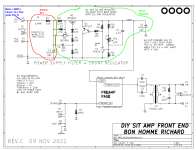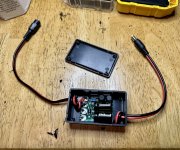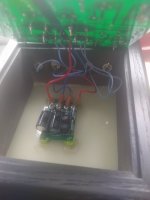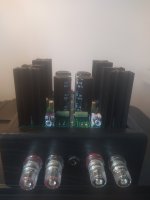Oh, and re measurements... sadly I don't believe we can measure all what matters re sound perception (as of know), but if you are concerned with measurements then when this filter discussion started some measurments were done, I even did some back then also but didn't post and was now that years away.
Bottom line : the resulting ripple was negligeable IMHO, and that even when applying Mark's filter to very average cheap SMPS. Having said that, the ripple with the std recommended SPMS was also already low, and yet I heard an improvement with the filter. I doubt the usual measurement give a clear cut, other that the filter works amazingly well on scope and ears.
For whatever it is worth...
Bottom line : the resulting ripple was negligeable IMHO, and that even when applying Mark's filter to very average cheap SMPS. Having said that, the ripple with the std recommended SPMS was also already low, and yet I heard an improvement with the filter. I doubt the usual measurement give a clear cut, other that the filter works amazingly well on scope and ears.
For whatever it is worth...
The Ship Of Theseus front end card called "Bon Homme Richard" (BHR), does both. Its power supply is a Mean Well SMPS, which is then filtered by FerriteBead + RLC, upstream of BHR. Then the front end card itself includes additional RLC filtering, followed by a shunt mode voltage regulator. Since each stereo channel has its own front end card with its own supply filtering, channel to channel crosstalk through the power supply is minimized.
_
_
Attachments
What of course lacks is the tryout of the linear PSU together with the filter. That would have been a more even comparison I think. Some would say that maybe that specific linear PSU was not clean (or the like). Another one: maybe a lab power supply (with probably banana plug cabling?) is not the right PSU for audio. Again another one: maybe that big lab power supply had a too light load. Last one: maybe a proven/reputable ultra low noise linear PSU with the right voltage/current ratings should have been used instead (one with TPS7A4700 or the like)... like a type that one would really use for audio stuff.Hi PKI,
No measurment but listening tests, to my own preference and all IMHO.
You may want to use the search function, but I tweaked a few bits on the B1K, including its PS caps, and eventhough I found the filter to be benefical to my ears.
Perhaps more importantly, I compared SMPS + Filter vs Big linear lab PS (see B1K thread) and the winner was SMPS+Filter. By a small margin though, as air gets really thin on this unit re PS tweaks at that stage.
I haven't tried the highly praised Salas shunt, so can't comment really, but for whatever it is worth:
- apart from taste and colour consideration, I doubt there is much more to be objectively gained in this set up
- SMPS + Filter are delivering an outstanding result and I learned the hard way that SMPS can sound fine (once filtered etc.), for sure in this application it is not the limiting factor re neutrality (read: the B1K has its own "sound print" that is both its beauty and for sure its dominant trait, whatever tweaks we might try)
And that is coming from someone who always believed a switcher couldn't compete with a linear PS re sound... I learned meanwhile, and perhaps also the tech has improved over the years.
Just my 2 ps, let u sknow your findings
Claude
IMHO the comparison seems to be too flawed to draw any conclusion. Such a comparison seems to be made with predefined preference for one of the compared items. Sorry.
Last edited:
For my educational purpose: in theory, SMPS has that ripple noise that is lets say 80mV p-p and also has those high freq. spikes that are switching noise. Does this filter helps to filter both ("Noise attenuation at 50 kHz is about 40dB (i.e. 100x); while at 200 kHz, noise attenuation is about 65dB")? Alternatively, as I understand linear PSU will only have ripple noise (also diode switching?), and something regulated like Salas UBiB will only have very very low ripple noise, correct?
No problem with different POV Jean-Paul, I will just add though that if I was biased, then defo in favour of the linear supply, as I had really big hopes and it was the first time one (NP of course) could convince me to even go that route!
I don't see why I should test a linear with said SMPS filter. Apart from adding indeed some capacitance value (they come in addition), I doubt very much the said filter can be of any help at low frequency, but indeed I haven't tried it as I have a dedicated clean line with dedicated filters already on the main for my system, but well. What I did though was testing with increasing the PS cap's value, so that any addition due to the filter's composition is IMHO negligeable.
Was the linear lab supply clean (it is on scope and by spec, but then... who knows what else should be measured), or suited (that's quite a short word for many possible definition re audio), I can't tell. It is suitable in terms of voltage, amperes, cleaness and response on the paper. But then in terms of audio I wouldn't say of course it is representative of Salas' shunt regulator or else, of course not by definition. Only a try can tell, hence me reading these lines in hope the OP will try and let us know. The loading is another point, although that lab PS has a variable load limiter but that indeed doesn't say if it likes low loads as the B1K. One thing is sure though: SMPS can have a lot of variable garbage depending on load!
A last point though: all what I tried re PS tweaks for the B1K was quite limited in terms of results vs other tweaks, so either I only tried crap tweaks (mainly increasing PS capacitance, lower ESR caps, SMPS filter(s), use of a lower ripple SMPS etc.)... or there is very little to be gained further re PS on the B1K once you have a good SMPS and Mark's filter.
Let us know... I am open minded and pursued other paths, as I 'felt' this was diminishing returns, but glad to be proven wrong by someone investaging farther.
Claude (not opening a can of worms of course)
I don't see why I should test a linear with said SMPS filter. Apart from adding indeed some capacitance value (they come in addition), I doubt very much the said filter can be of any help at low frequency, but indeed I haven't tried it as I have a dedicated clean line with dedicated filters already on the main for my system, but well. What I did though was testing with increasing the PS cap's value, so that any addition due to the filter's composition is IMHO negligeable.
Was the linear lab supply clean (it is on scope and by spec, but then... who knows what else should be measured), or suited (that's quite a short word for many possible definition re audio), I can't tell. It is suitable in terms of voltage, amperes, cleaness and response on the paper. But then in terms of audio I wouldn't say of course it is representative of Salas' shunt regulator or else, of course not by definition. Only a try can tell, hence me reading these lines in hope the OP will try and let us know. The loading is another point, although that lab PS has a variable load limiter but that indeed doesn't say if it likes low loads as the B1K. One thing is sure though: SMPS can have a lot of variable garbage depending on load!
A last point though: all what I tried re PS tweaks for the B1K was quite limited in terms of results vs other tweaks, so either I only tried crap tweaks (mainly increasing PS capacitance, lower ESR caps, SMPS filter(s), use of a lower ripple SMPS etc.)... or there is very little to be gained further re PS on the B1K once you have a good SMPS and Mark's filter.
Let us know... I am open minded and pursued other paths, as I 'felt' this was diminishing returns, but glad to be proven wrong by someone investaging farther.
Claude (not opening a can of worms of course)
To open the can of worms I did exactly the opposite and after many tests no SMPS will be used anymore in my low power applications. There is nothing to be gained by chosing SMPS in low power audio devices. Power efficiency, low cost and certifications/labels are last on the priority list.
In my professional life I can not and also don’t want to do without SMPS. Just to show they of course have merits but professional stuff is another league compared to consumer grade cheap 5…24V at max. 2A wall wart stuff. My popping cap syndrome, sometimes extreme EMI, their variable/light load behavior and their 24/7 operational life don’t help either. Switching DC is plain silly so no go. It is low cost and avoiding liability as main qualities and then defending irrelevant features all over.
Also building good linear PSUs is an art that is rewarding.
Enough off topic stuff, my apologies.
In my professional life I can not and also don’t want to do without SMPS. Just to show they of course have merits but professional stuff is another league compared to consumer grade cheap 5…24V at max. 2A wall wart stuff. My popping cap syndrome, sometimes extreme EMI, their variable/light load behavior and their 24/7 operational life don’t help either. Switching DC is plain silly so no go. It is low cost and avoiding liability as main qualities and then defending irrelevant features all over.
Also building good linear PSUs is an art that is rewarding.
Enough off topic stuff, my apologies.
Last edited:
Hi all,
@Mark Johnson Is this current sense res a good alternative?
https://www.mouser.it/ProductDetail/Ohmite/12FR040E
OAR1R040JLF seems to be quite unobranium at today...
🍻
@Mark Johnson Is this current sense res a good alternative?
https://www.mouser.it/ProductDetail/Ohmite/12FR040E
OAR1R040JLF seems to be quite unobranium at today...
🍻
Please show everyone the work you have done so far. Create a table which includes the important features and specifications of both. Column A of the table is Feature Name. Column B of the table is the value for Original_Resistor. Column C of the table is Proposed_Replacement_Resistor.
Include the specs and features that you think are important, such as length, width, lead-to-lead spacing on PCB, resistance, wattage, tolerance, price, number of parts on the shelf at Mouser, probability of counterfeit, and so forth.
Include the specs and features that you think are important, such as length, width, lead-to-lead spacing on PCB, resistance, wattage, tolerance, price, number of parts on the shelf at Mouser, probability of counterfeit, and so forth.
@Mark Johnson i have found quite a bit of suitable smd components. Do you feel smd would work as well as TH (stocks are much much larger and easy obtainable, and with the nature of the market, won't be obsolete as quickly)? I'm inclined to make a new pcb that consists of mostly smd components, and only caps as trough hole.
Please D.I.Y. whatever you wish using whichever components you prefer, with my blessings and good wishes! Be sure to give your PCB a new name that does not resemble "PO89ZB" to avoid confusion, and to ensure that future requests for technical support flow to you and not to the Store or to this Forum thread.
You may also want to read post #9 in this thread, you might or might not find it useful.
You may also want to read post #9 in this thread, you might or might not find it useful.
It would be 1 to 1 replacement but in SMD package, and keep the trough hole capacitor (perhaps even inductor, it seems in decent quantity now). As it is harder and harder to obtain 40mohm resistors.Please D.I.Y. whatever you wish using whichever components you prefer, with my blessings and good wishes! Be sure to give your PCB a new name that does not resemble "PO89ZB" to avoid confusion, and to ensure that future requests for technical support flow to you and not to the Store or to this Forum thread.
You may also want to read post #9 in this thread, you might or might not find it useful.
I finally implemented one of these little filters, using it with my ACP+. Works great! Thanks, Mark J!
It just fits in this little ABS enclosure. I ordered male and female jack cables to go along with the box.
https://www.amazon.com/gp/product/B07F3Y8L95/
https://www.amazon.com/gp/product/B072BXB2Y8/
Now to spread them all around the house to other equipment! ACA Mini next!
It just fits in this little ABS enclosure. I ordered male and female jack cables to go along with the box.
https://www.amazon.com/gp/product/B07F3Y8L95/
https://www.amazon.com/gp/product/B072BXB2Y8/
Now to spread them all around the house to other equipment! ACA Mini next!
Attachments
Sorry, previous link doesn't work.Please show everyone the work you have done so far. Create a table which includes the important features and specifications of both. Column A of the table is Feature Name. Column B of the table is the value for Original_Resistor. Column C of the table is Proposed_Replacement_Resistor.
Include the specs and features that you think are important, such as length, width, lead-to-lead spacing on PCB, resistance, wattage, tolerance, price, number of parts on the shelf at Mouser, probability of counterfeit, and so forth.
Part is that:
https://www.mouser.it/ProductDetail/Ohmite/12FR040E?qs=uiw/yAg7Uev2ekwVjivpIw==
It is 10,6mm long, so I think useable in that LS.
2W instead of 1.
Congratulations @Alan D UK ! A very tidy build with lots of eye appeal. Good on ya.
Looks like there's plenty of room in your "basement" to experiment with using N>1 SMPS filter cards in series, if you want to. Take the incoming, less-than-clean DC from the SMPS, and filter it through a PO89ZB. Then take the much-cleaner DC and filter it again through another. Iterate as many times as you see fit.
Looks like there's plenty of room in your "basement" to experiment with using N>1 SMPS filter cards in series, if you want to. Take the incoming, less-than-clean DC from the SMPS, and filter it through a PO89ZB. Then take the much-cleaner DC and filter it again through another. Iterate as many times as you see fit.
Thanks for your kind words. I do have some cards that members kindly sent me still, is there a noticeable improvement having two in series.
Thanking you for the design.
Thanking you for the design.
A few people here have tried the experiment and posted their listening evaluations. I didn't save links, unfortunately.
- Home
- Source & Line
- Analog Line Level
- PO89ZB, an inline DC filter for SMPS wall warts. Preamps, HPA, Korg NuTube, etc




